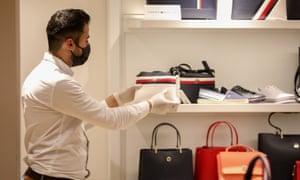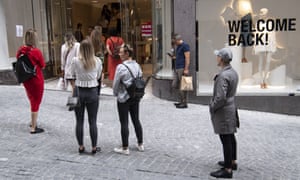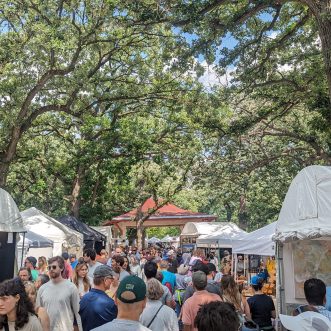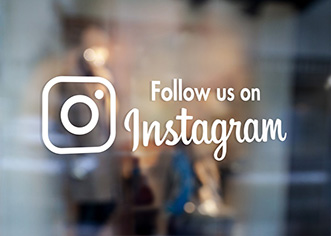The Hermès store in China that took £2.1m in one day after reopening. Photograph: Alex Plavevski/EP
___
…here’s how to make it simpler. With shops due to reopen, customers can expect a very different experience. Do your research online first, buy before you try – and avoid jeans.
Picture the scene: you walk into your favourite clothes store for the first time in three months, check your mask is covering your nose and mouth, and pump sanitiser into your hands. And then you spot it – the perfect gingham dress. Just the mood-boosting, picnic-appropriate fillip your wardrobe needs, and it is just there, on the other side of the shop floor. But, instead of making a beeline for it, you have to take the long way round, following the one-way system marked out in arrow stickers on the floor, pausing when the shopper in front of you does in order to observe the two-metre-rule (the pandemic-era grandmother’s footsteps that we have grown used to in the supermarket aisles). And then – disaster – the masked shopper in front of you reaches for your gingham dress and takes the last one in your size. Which means that, if she doesn’t buy it, it will be headed for quarantine in the stock room, rather than back to the shop floor.
But reports from post-lockdown all over the world suggest that there is likely to be an appetite for a post-quarantine clothes splurge. A Hermès boutique in Guangzhou took the equivalent of £2.1m on its first Saturday after reopening, setting a record for a single day in a single boutique in China’s retail history. Wherever Zara stores have opened their doors from Paris to Tunis, shoppers have formed long first-day queues.

With warehouses of unsold summer stock to shift, retailers are at pains to do everything they can to make customers feel safe. Some of the basics will be universal. In-store numbers will be strictly limited, so expect queues outside. Stores with more than one door may operate separate entrances and exits to avoid face-to-face contact at these points. Masks will be worn by staff, and shoppers will be encouraged to follow suit. Contactless payment will be encouraged (expect a push on Apple Pay and other mobile payment services, which are not usually subject to the £45 limit) and sanitiser pumps stationed by each cash desk. Only household members can shop together, and lift occupancy will be limited to one person or those from one household.
Lots of things will vary between stores, however. In the first wave, many will open only those branches whose customer base can travel by foot, bike or car. John Lewis will keep changing rooms closed for now, but Reiss and Gap will open some, with rigorous sanitising between customers.
Jewellery and watches will be particularly challenging to try on, as the virus can live on metal for much longer than on fabric. Most stores have extended their returns policy to encourage shoppers to try clothes on at home; John Lewis is considering installing “drop boxes” at store entry points, so that returns need not add to in-store footfall. Some shops will open for shorter hours so that staff don’t need to travel at rush hour, others will open for longer to spread out footfall. Selfridges is considering reducing the amount of stock on the shop floor so that shoppers can give each other more space. Harrods will open an outlet at the west London Westfield shopping centre in July where the traditional tightly packed sales rails can have more room. Most stores will keep cafes closed, but 49 Marks & Spencer stores will sell takeout coffees. Some stores will have toilets open – but as one PR told me off the record, those that will aren’t keen to broadcast the fact and become de facto public toilets while few alternatives are available.
Even the greatest cheerleader for the embattled retail industry would struggle to frame this as an enticing day out. Vigilance over meticulous hygiene may reassure customers that they are safe, but that is not the same as making them feel relaxed, happy and in the mood to spend. After all, until three months ago, bricks-and-mortar retail relied on delivering a fun experience to tempt shoppers offline – and “sterile” was one of the most damning verdicts you could deliver.

___
“You need a plan,” says Helen Seamons, the Guardian’s menswear fashion editor and a gold-standard shopper, when I ask for her tips for a successful physically distanced shopping trip. “The age of the aimless browse is over for now. And the etiquette of flicking through rails seems doubtful. So do an online recce and save screenshots to your phone of pieces you like. That way you can ask staff where they are, and reduce your wandering-about time.” Some small neighbourhood boutiques that will have capacity for only one or two shoppers at a time plan to offer short bookable appointments rather than having customers lined up outside.

Alternatively, this could be the time to pivot to online clothes shopping. The best place to start is with a brand you already wear, so that you have a good sense of what size you take and a realistic expectation of what the fabric and finish will be, these being tricky to assess online. Melanie Wilkinson, the Guardian’s styling editor, suggests: “This probably isn’t the best time to buy a new pair of jeans – historically, the one item that requires hours of trying on. Continue to embrace the smart jogging-bottom trend of lockdown instead. You can wear these with silk blouses and relaxed shirts, which are easier to shop for online.” Order several pieces at once and expect to send most of them back – if you only order one item, you might be tempted to convince yourself you like it to save the bother of returning it. But whether you are shopping in store or online, you won’t be taking anyone with you into a changing room for a while.
To recreate shopping with friends, consider setting up a WhatsApp group for honest advice so that each of you can try on new purchases in front of the mirror and send selfies for feedback. (Consider carefully who you want to include in this group. Does their taste match with yours? How much brutal honesty is too much? Will it annoy you if they copy what you buy?)
Things will get better. Swifter sanitising systems, some using ozone-based technology and others ultraviolet light, are being worked on, with a view to reducing the quarantine time for clothes that customers have been handled to an hour or less. Zara already has an online fit tool that uses your height, weight and body shape to recommend which size you buy – so far, this has always worked out for me, although the hit rate is inconsistent between different body shapes and sizes. Amazon is developing an app that will “data mine” photos from your phone to create a bespoke virtual mannequin that accurately represents your body shape, which can then “try on” clothes. The new normal is a strange place. Anyone for retail therapy?
___
Americans have had enough …
… and are marching for justice in unprecedented numbers. In small towns and big cities across the country, thousands of people are giving voice to the grief and anger that generations of black Americans have suffered at the hands of the criminal justice system. Young and old, black and white, family and friends have joined together to say: enough.
The unconscionable examples of racism over the last weeks and months come as America’s communities of color have been hit hardest by the coronavirus and catastrophic job losses. This is a perfect storm hitting black Americans. Meanwhile, the political leadership suggests that “when the looting starts, the shooting starts”. The president who promised to end the “American carnage” is in danger of making it worse.
At a time like this, an independent news organisation that fights for truth and holds power to account is not just optional. It is essential. Because we believe every one of us deserves equal access to fact-based news and analysis, we’ve decided to keep Guardian journalism free for all readers, regardless of where they live or what they can afford to pay. This is made possible thanks to the support we receive from readers across America in all 50 states.







